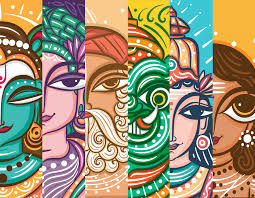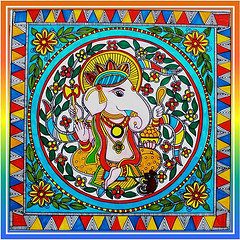
Menu

Madhubani art, also known as Mithila painting, is one of India’s most celebrated folk art traditions. It originates from the Mithila region of Bihar and parts of Nepal, where it has been practiced for centuries—passed down from mothers to daughters, generation after generation. Once painted on mud walls and floors to mark festivals and life events, it now graces paper, cloth, and canvas, finding admirers worldwide.
What makes Madhubani art instantly recognizable is its striking use of geometric patterns, bold lines, and vibrant colours. Artists often use double borders, intricate florals, and repeated motifs to create hypnotic symmetry. Natural elements such as fish, peacocks, trees, and the sun feature prominently, symbolizing fertility, prosperity, and harmony with nature.
Traditionally, Madhubani paintings served ritual and decorative purposes. During weddings, artists adorned the kohbar (nuptial chamber) walls with images of gods, nature, and love to bless the couple. Deities like Krishna, Shiva-Parvati, and Durga are common subjects, drawn with devotion and attention to detail. Scenes from the Ramayana and Mahabharata are also popular, bringing epic tales alive with folk aesthetics.
Historically, artists used natural pigments sourced from plants, clay, turmeric, and soot, applying colour with twigs, fingers, or matchsticks. Even today, many Madhubani painters honour these traditional methods, keeping the art form sustainable and close to nature. This use of organic materials also gives the paintings a distinctive earthy charm.
In modern times, Madhubani art has evolved without losing its roots. Artists now create on paper, canvas, sarees, and even walls in urban spaces. Women who once painted for household rituals now support their families by selling their work, making Madhubani a powerful tool for women’s empowerment and cultural preservation. Government initiatives and NGOs have helped bring Madhubani to global markets, making it a sought-after collector’s item.
More than just decoration, Madhubani art is a living tradition—an archive of community wisdom, mythology, and ecological respect. It is a testament to the creativity of rural India, where art is not a luxury but a way of life, connecting the everyday with the divine.

@THE INDIAN ART COTTAGE
© The Indian Art Cottage | All Rights Reserved | 2025